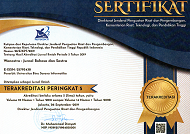Blending Construction In English Foods And Beverages In Indonesia: Linguistics And Cultural Views
Abstract
This research aims at investigating the composing of the portmanteau word in food and beverage names or brands in Indonesia referring to the types of blending in the source word proposed by John Algeo. Based on the linguistic and cultural view, the fact shows the name or brand of foods and beverages carry their characteristics, identities, and motives in its usage. The descriptive qualitative method is applied in this study by collecting the English food and beverage name or brand taken from offline and online searching. Offline data is searched by the observation in Mall, shop, and restaurant. Online data is gained from the internet web starting from March up to May. The collected data from online and offline is tabulated all together into types of blending then shorted the source word to reveal the structure of the word class and its phonology. This study brings out the results of the blending process into 4 categories: Complex Clipped Word, Back Clipped Word, The combination of Fore and Back Clipped Word, and Phonemic Overlapping and Clipping. The culture contained in the portmanteau words (the English foods and beverages name) is revealed in the origins of the source words (Borrowing word). They are 13 borrowed words are composed of the name of English foods and beverages. This study is important to develop the fundamental aspects of blending in English food and beverages in Indonesia by looking at the linguistic view and its relation to cultural view.
Full Text:
PDFReferences
Algeo, J. (2010). The Origins And Development Of The English Language (6th Editio; Megan Garvey; Rebekah Matthews, Ed.). Retrieved from https://books.google.com/books?hl=en&lr=&id=1aJ9U9nrjqsC&oi=fnd&pg=PP1&dq=The+Origins+And+Development+Of+The+English+Language&ots=ZxNdQit-wq&sig=Qz_A1IAUIBFzO1vrN2ebJI8nHCs.
Čolić, A. M. (2015). Word Formation Of Blends. Moustariensia-Journal of Social Sciences and Humanities, (2), 21–36. Retrieved from https://www.researchgate.net/publication/327605690_WORD_FORMATION_OF_BLENDS.
Cong, S. C. (2016). Fill My Cup Half Full: Boba Stories (University of California). Retrieved from https://escholarship.org/uc/item/461210j5
Fajrin, E. (2017). An Analysis Of Word Formation In Jargon Used By Xiaomi Faculty Of Humanities (Universitas Islam Negeri Maulana Malik Ibrahim). Retrieved from https://core.ac.uk/download/pdf/160461861.pdf
Fatmaway, Riryn & Anggraini, P. A. (2019). An Analysis Of English Word Formation Processes In Beats Apart Novel By Alanda Kariza And Kevin Aditya. E-Link Journal, 6(01), 164–182.
Giyatmi; Wijayava; Arumi. (2018). Blending Sebuah Alternatif Dalam Penamaan Makanan Dan Minuman Ringan. Adabiyyāt: Jurnal Bahasa Dan Sastra, II(2), 156–180. Retrieved from https://www.google.com/url?sa=t&rct=j&q=&esrc=s&source=web&cd=12&cad=rja&uact=8&ved=2ahUKEwiBnb2-477oAhWJe30KHagXDNMQFjALegQIAxAB&url=https%3A%2F%2Fwww.researchgate.net%2Fpublication%2F334305770_BLENDING_SEBUAH_ALTERNATIF_DALAM_PENAMAAN_MAKANAN_DAN_MINUMAN_RINGAN&usg=AOvVaw24ArmNL542p7gf3BVQfS95
Hosseinzade, N. M. (2014). New Blend In the English Language. International Journal of English Language and Linguistics Research, 2(2), 15–26. Retrieved from www.ea-journals.org
Kjellander, D. (2015). Beauty And The Blend (Stockholm University). Retrieved from http://www.diva-portal.org/smash/record.jsf?pid=diva2:821138
Komara, C. (2015). Analisis Struktur Lexical Blend Nama Produk Waralaba Indonesia. Universitas Pendidikan Indonesia. Konferensi Linguistik Tahunan Atma Jaya 13, 1–8. Retrieved from https://www.google.com/url?sa=t&rct=j&q=&esrc=s&source=web&cd=17&ved=2ahUKEwiBnb2-477oAhWJe30KHagXDNMQFjAQegQIBxAB&url=https%3A%2F%2Fosf.io%2Fvyag2%2Fdownload&usg=AOvVaw1vbOPJgpMieK5Vh-bRPtSY
Lestari, desi indah. (2017). Pemakaian Bahasa Pada Iklan Produk Minuman Di Televisi Dan Implikasinya Dalam Pembelajaran Menulis Slogan Dan Poster Di Sekolah Menengah Pertama (Universitas Lampung Bandarlampung). Retrieved from http://digilib.unila.ac.id/26339/
Purwani, N. (2013). Penggunaanbahasa Inggris Dalam Iklanmakanan Dan Minuman: Peluang Ataukah Ancaman? International Seminar “Language Maintenance and Shift III”, Semarang, July 2-3, 2013, 346–350. Retrieved from http://eprints.undip.ac.id/54466/
Rini, R., & Moehkardi, D. (2019). English Blends in Indonesian Context : Their Formation Processes and Meanings. Humaniora, 31(1), 21–32. Retrieved from https://journal.ugm.ac.id/jurnal-humaniora/article/view/40374
Shaw, K. (2013). Head Faithfulness In Lexical Blends : A Positional Approach To Blend Formation (the University of North Carolina). Retrieved from http://linguistics.unc.edu/files/2011/11/5240.pdf
Sundari, W. (2008). Proses Pembentukan Nama-Nama Menu Makanan Berbahasa Inggris. Universitas Dipenogoro
DOI: https://doi.org/10.31294/w.v12i2.8989
Copyright (c) 2020 Sulhizah Wulan Sari, Rini Martiwi

This work is licensed under a Creative Commons Attribution-ShareAlike 4.0 International License.
Index by:
Published by Department of Research and Community Service (LPPM) Universitas Bina Sarana Informatika by supported Relawan Jurnal Indonesia
Jl. Kramat Raya No.98, Kwitang, Kec. Senen, Jakarta Pusat, DKI Jakarta 10450

This work is licensed under a Creative Commons Attribution-ShareAlike 4.0 International License






